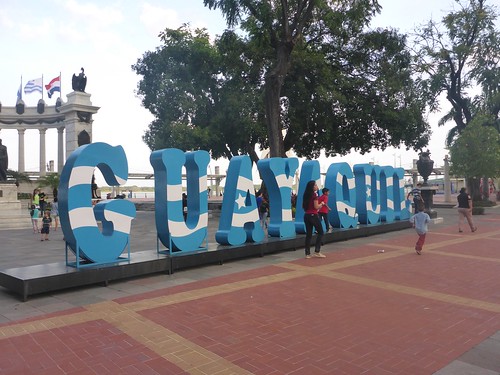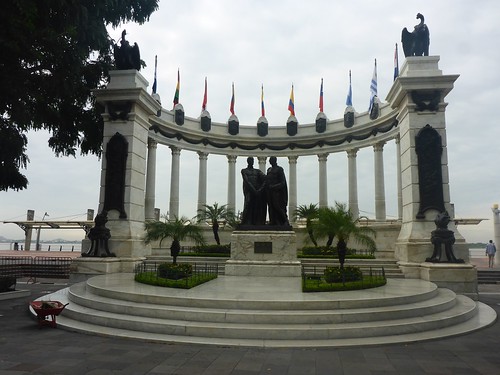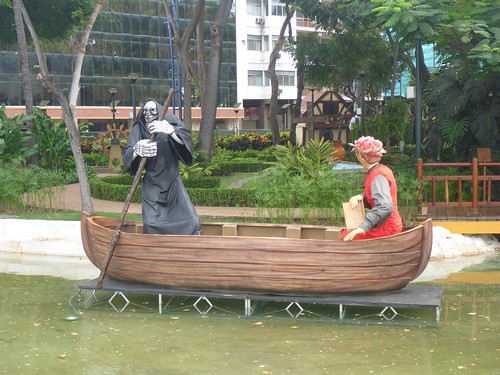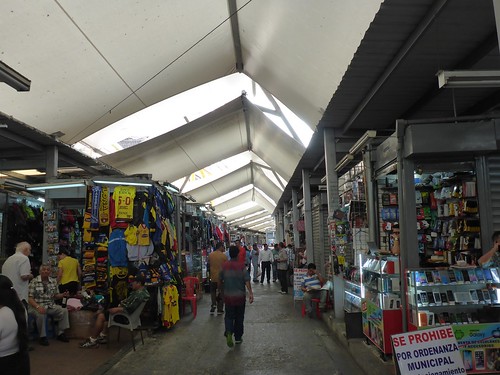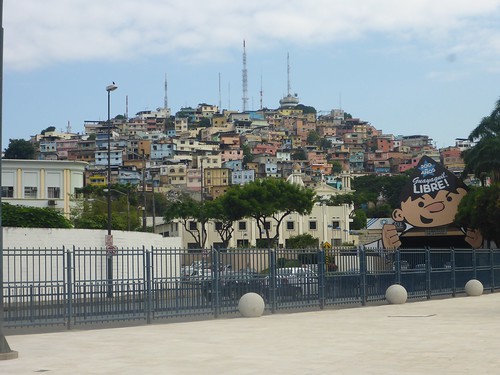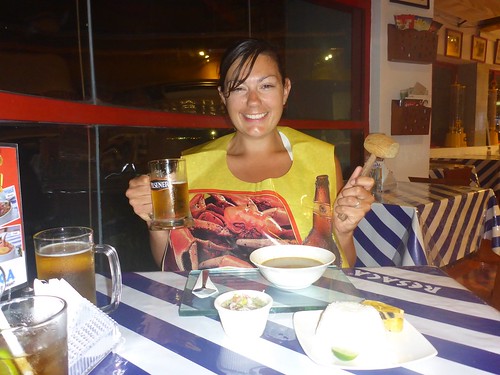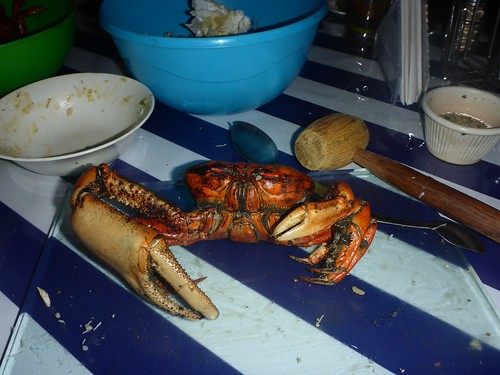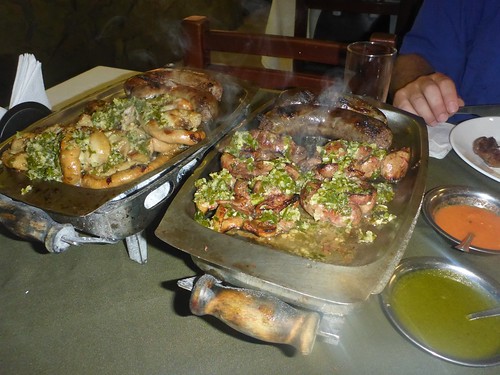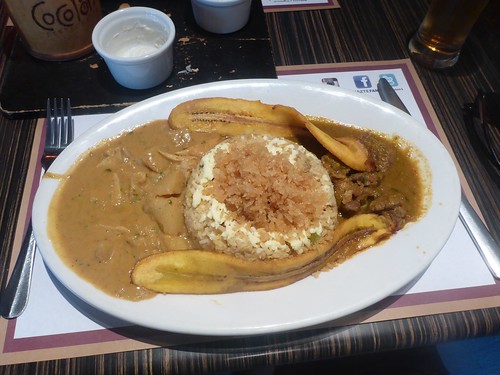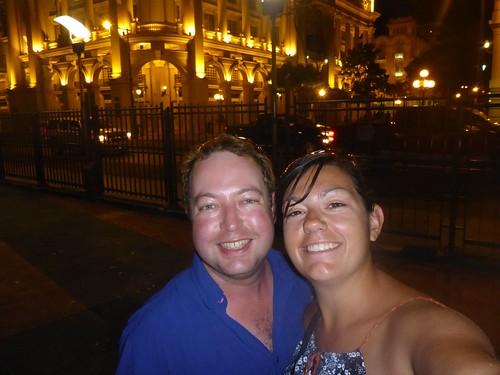Santiago de Guayaquil, known as Guayaquil and pronounced as Gwuy-a-kill. The gateway to the Galapagos (although we didn’t go there), the most popular city in Ecuador and strangely lacking in touristy things to do, but Simon Bolivar made an appearance.
How not to annoy immigration, or the rest of the bus
Once we crossed the border into Ecuador, it started being even more tropical, and we passed through around 40km of banana plantations. The roads were much better than Peru, with almost no potholes or speed bumps on the highway. We made it through the border crossing unscathed; however some other people on our bus managed to lose their exit slip from Peru, consequently delaying us by a half hour… luckily we had a shady spot of cement to sit on by the side of the road while we waited for them to sort themselves out. We eventually arrived to Guayaquil and found our hostel, then went on to find a recommended place for dinner that served ribs. After the raving reviews from the receptionist we were expecting a half decent restaurant with sit-down service; we were arrived to a take-away place but the food wasn’t bad.
On the boardwalk
Having finally gotten ourselves a decent night sleep and very thankful to not be on a bus again, we decided that Wednesday would be spent looking around at a few of the local tourist attractions. One of Guyaquil’s most prominent spaces is the ‘Malecón 2000’, a 2.5km boardwalk lining the Guayas River. The boardwalk was originally named after Simón Bolivar, and has plenty of statues of him and his mates sprinkled along the shoreline.
A few years back the local government decided that it was time to refurbish the area, along with a few museums, restaurants, shopping malls and a couple of food court kind of arrangements, the boardwalk is home to South America’s first IMAX theatre.
For the few days that we were in Guayaquil we’d spent a large amount of time at the Malecón exploring the parks and market places. The artesenal markets were tiny, and barely worth the walk to the very end of the pier; however, the local commercial markets nearby were massive! Aisles and aisles of football shirts, phones, batteries, watches, radios, shoes… everything you could possibly ever need.
Walking the Giant Hill
After the couple of kilometres walking one direction on the boardwalk we came across the neighbourhood of Las Peñas, which is the beginning of a fairly steep ascent toward Cerro Santa Ana. Las Peñas is one of the city’s oldest neighbourhoods, with some of the houses being built over 400 years ago - many of which have been restored and turned into art galleries.
We began up the hill of Santa Ana but managed to take a couple of wrong turns and end up closer to the river than we did the peak. Getting some directions from security guards along the way, and then realising that the stairs were numbered we eventually got ourselves heading in the right direction. Many of the stairs were lined with pubs and bars, the occasional corner shop, and a lot of barred windows with old ladies peering out. By the time we arrived to the top we were very thankful for a slight breeze off the river, and a guy selling water. Cerro Santa Ana is home to Guayaquil’s first church and town hall; it also has a pretty cool looking lighthouse.
All of the food
So along with some pretty scenery and walks along the river, no city would be complete without trying the best they had to offer in food. Along the Malecón 2000 there is a sprinkling of restaurants who offer cocktails, food deals and some shonky coffee; in saying that, one place we came across offered all you can eat crab for an absolute steal at $16.99 US.
A little sceptical of the “all you can eat” sign (is it really all you can eat when you have inverted commas around the phrase?) we decided that we’d at least give the place a go for dinner. We sat down, were brought bibs and a tiny side plate of salad and beers. Then came the crabs… we had two buckets, one with Ecuadorian spices, and the other stir-fried in garlic. By the end of the evening we’d gotten through eight small crabs between us and were absolutely chocker-block full; we did however, watch another table eat six per person… Now these crabs aren’t the massive muddies that you get in Australia but they are definitely a decent size, and this place was definitely all you can eat!
Artesenal markets… and more food
So Thursday we rolled out of bed, still stupidly full from our overfeed of crabs we bypassed breakfast and headed back down to the Malecón to try and walk off some of the excess food. Arriving to the main fence we were greeted with a giant ‘Guayaquil’ sign that popped up overnight in front of Simón Bolivar. We headed toward the markets and then back around to a Parilla for lunch, where James decided that we needed a massive amount of barbecue meats… surprise!
An arvo at the hostel
When one has too much meat they need to lie down… Our hostel room in Guayaquil was pretty awesome, our room was cleaned daily, and there were towels, a bath mat, a toilet seat and even an extraction fan! Unfortunately the intake is above the toilet, the outflow is to the main room, and it’s triggered by the light switch - so if you do anything smelly in there, the room suffers :( Hooray!
Friday morning it was time to go back to the bus station and get ready for another terrifying bus trip, this one was during the day… on a local bus… with no allocated seats… and a stop every two minutes to collect/drop off/lose someone. The patience for bus trips is dwindling! On the plus side we are off to a new city! Bring on Cuenca.
Go see all the photos from Guayaquil
